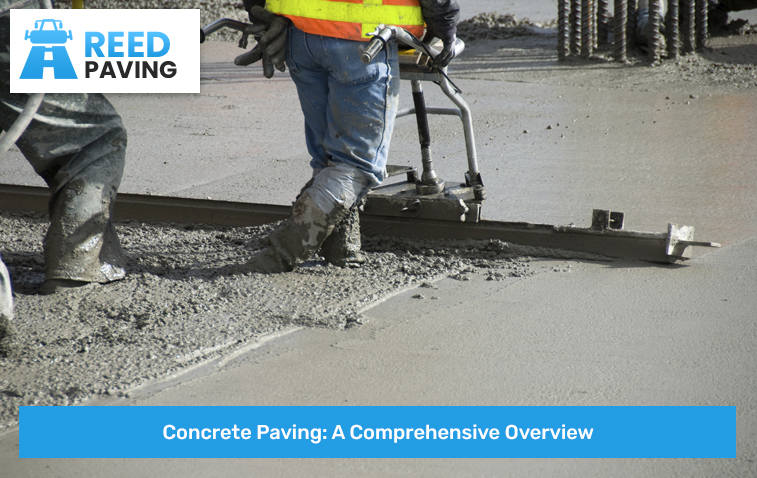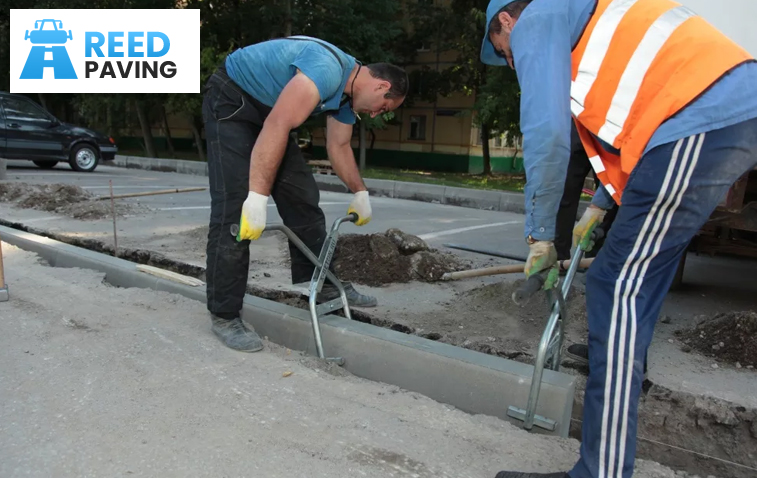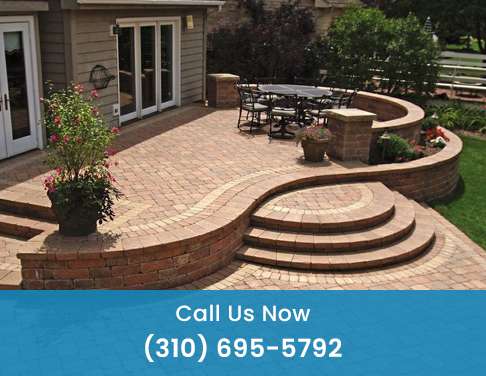Concrete Paving: A Comprehensive Overview
Concrete paving has long been a popular choice for driveways, patios, sidewalks, and other outdoor areas. It’s a strong, durable material that provides a clean and smooth surface for walking, driving, or simply enjoying your outdoor space. Concrete paving offers many benefits, including low maintenance, durability, and versatility.
Whether you’re looking to create a simple path in your garden or a sturdy driveway, concrete is a material that can meet your needs. It’s long-lasting and can handle a lot of wear and tear, making it ideal for areas that see heavy foot or vehicle traffic. Concrete paving is more than just a practical solution; it can also be decorative, with various textures and colors available to suit any style.

1. What is Concrete Paving?
Concrete paving involves laying a solid slab of concrete over an area to create a smooth, flat surface. It is commonly used for outdoor spaces like driveways, walkways, patios, and even roads. Concrete is made by mixing cement, water, sand, and gravel, which hardens over time to create a strong, durable surface.
How Concrete Paving Works
Concrete paving is usually poured into forms to create the desired shape and size. Once poured, it needs time to cure, or harden, which can take a few days depending on the weather. During the curing process, the concrete gains strength and becomes a solid, reliable surface.
Simple Explanation:
- Mixing Concrete: Concrete is made by mixing cement, water, sand, and gravel.
- Pouring Concrete: The mixture is poured into forms to create the desired shape.
- Curing Time: The concrete hardens over a few days to form a strong surface.
Types of Concrete Paving
There are different types of concrete paving, including stamped concrete, plain concrete, and exposed aggregate concrete. Stamped concrete is textured to mimic the look of brick or stone, while plain concrete is smooth and simple. Exposed aggregate concrete has a textured surface with the gravel showing through.
Simple Explanation:
- Stamped Concrete: Textured to look like brick, stone, or other materials.
- Plain Concrete: Smooth, flat, and simple in appearance.
- Exposed Aggregate: Has a rougher texture with visible gravel.
2. Benefits of Concrete Paving
Concrete paving offers many benefits, making it one of the most popular choices for outdoor spaces. It is durable, low-maintenance, and versatile, with many options for customization.
Durability
Concrete is incredibly strong and can last for decades if properly maintained. It can handle heavy loads, making it ideal for driveways and roads. Even in harsh weather conditions, concrete holds up well, resisting cracking and damage.
Simple Explanation:
- Long-Lasting: Concrete can last for many years without needing major repairs.
- Handles Heavy Traffic: Concrete is strong enough for vehicles and heavy foot traffic.
- Resistant to Weather: It holds up well in both hot and cold weather.
Low Maintenance
One of the biggest benefits of concrete paving is that it requires very little maintenance. Once installed, concrete only needs occasional cleaning and sealing to keep it in good condition. Unlike other materials, it doesn’t require frequent repairs or replacements.
Simple Explanation:
- Easy to Maintain: Concrete needs only minimal upkeep, like cleaning and sealing.
- Few Repairs Needed: It doesn’t crack or break easily, so repairs are rare.
- Long-Term Solution: Concrete paving stays in good shape with little effort.
Versatility
Concrete paving comes in many different styles and colors, making it a versatile option for any outdoor space. You can choose from smooth, textured, or patterned finishes to match your home’s aesthetic. Whether you want a modern look or something more traditional, concrete can be customized to fit your style.
Simple Explanation:
- Customizable: Concrete can be textured or colored to match your style.
- Many Designs Available: You can choose from different patterns and finishes.
- Versatile Use: Concrete is perfect for driveways, patios, sidewalks, and more.
3. Installation Process of Concrete Paving
The installation of concrete paving is a step-by-step process that requires precision and attention to detail. From preparing the site to finishing the surface, each step is important to ensure the concrete is laid correctly.
Preparing the Site
Before pouring the concrete, the site needs to be prepared. This involves clearing the area of debris and leveling the ground to create a smooth surface. Forms are then placed around the edges to define the shape of the concrete slab.
Simple Explanation:
- Clear the Area: The ground is cleared and leveled to make it smooth.
- Place Forms: Forms are put in place to shape the concrete.
- Ready for Pouring: Once prepared, the site is ready for the concrete to be poured.
Pouring and Leveling the Concrete
The concrete is mixed and poured into the forms. It’s then spread evenly and leveled using special tools. The surface is smoothed out to create a flat, even finish.
Simple Explanation:
- Pour the Concrete: The mixed concrete is poured into the forms.
- Level the Surface: Tools are used to spread and level the concrete.
- Smooth Finish: The surface is smoothed to create a flat, even surface.
Curing and Sealing
After the concrete is poured, it needs time to cure. This process can take several days, during which the concrete becomes harder and stronger. Once cured, the surface can be sealed to protect it from stains and weather damage.
Simple Explanation:
- Curing Time: The concrete takes a few days to fully harden.
- Sealing the Surface: A sealant is applied to protect the concrete from damage.
- Ready for Use: Once cured and sealed, the concrete is ready for use.
4. Common Uses for Concrete Paving
Concrete paving is used in many different settings because of its strength and versatility. From driveways and patios to commercial parking lots, concrete is a popular choice for outdoor surfaces.
Driveways
Concrete driveways are one of the most common uses for concrete paving. A concrete driveway provides a smooth, durable surface for cars and can withstand the weight of vehicles without cracking or breaking.
Simple Explanation:
- Strong Surface: Concrete driveways can handle the weight of cars.
- Smooth Ride: The surface is smooth, making it easy to drive on.
- Durable Option: Concrete lasts a long time, even with heavy use.
Patios
Concrete is also a popular choice for patios. It’s easy to clean, provides a stable surface for furniture, and can be customized to create an inviting outdoor space. With stamped or textured concrete, you can even mimic the look of stone or brick.
Simple Explanation:
- Perfect for Patios: Concrete creates a stable, durable patio surface.
- Customizable Look: Stamped concrete can look like stone or brick.
- Easy to Clean: The surface is simple to maintain and keep clean.
Walkways and Sidewalks
Concrete is ideal for walkways and sidewalks because it creates a flat, even surface for walking. It’s also weather-resistant, so it won’t become slippery or damaged by rain or snow.
Simple Explanation:
- Safe Surface: Concrete walkways are smooth and even, making them safe to walk on.
- Weather-Resistant: Concrete holds up in all types of weather, from rain to snow.
- Long-Lasting Paths: Sidewalks made of concrete are strong and last for years.
Commercial Use
In commercial settings, concrete is often used for parking lots, roads, and loading docks. Its strength and durability make it the perfect material for areas that see heavy use.
Simple Explanation:
- Strong for Commercial Use: Concrete can handle heavy traffic, making it perfect for parking lots.
- Long-Lasting Surface: Commercial concrete paving lasts for many years with little maintenance.
- Ideal for Heavy Loads: Concrete is strong enough for trucks and other heavy vehicles.
5. Maintaining Concrete Paving
While concrete is low-maintenance, there are a few steps you can take to keep it looking and functioning its best. Regular cleaning, sealing, and addressing any cracks early can extend the life of your concrete paving.
Cleaning Concrete
Cleaning concrete is easy. All it takes is a regular sweep and the occasional power wash to remove dirt, stains, and debris.
Simple Explanation:
- Sweep Regularly: Keep the surface clean by sweeping it often.
- Power Wash: Use a power washer to remove tough stains and dirt.
- Easy to Clean: Concrete paving is simple to keep clean and looking fresh.
Sealing Concrete
Sealing concrete helps protect it from stains, water, and other damage. It’s a good idea to seal your concrete every few years to keep it in top shape.
Simple Explanation:
- Apply Sealant: Sealing helps protect the concrete from stains and weather.
- Lasts Longer: Sealing your concrete regularly extends its lifespan.
- Maintain the Look: Sealant keeps the concrete looking new and fresh.
Repairing Cracks
If you notice small cracks in your concrete, it’s important to repair them quickly. Small cracks can grow larger over time, so filling them early prevents bigger problems.
Simple Explanation:
- Fix Cracks: Repair small cracks early to prevent bigger issues.
- Prevent Damage: Filling cracks helps keep the concrete strong and durable.
- Simple Repairs: Cracks can be filled easily to avoid further damage.
Concrete paving is a strong, durable, and versatile choice for any outdoor space. Whether you’re looking to install a new driveway, patio, or walkway, concrete offers a long-lasting solution that requires minimal maintenance. With a variety of styles and finishes to choose from, you can customize your concrete paving to suit your personal style and the needs of your home or business. By understanding the benefits of concrete paving and how to care for it, you can enjoy a beautiful and functional outdoor space for years to come.
FAQ
Concrete paving can last for decades with proper maintenance. It’s a durable material that can handle heavy traffic and harsh weather conditions, making it a long-lasting solution for outdoor spaces.
Yes, concrete paving can be customized with different textures, patterns, and colors. Stamped concrete can mimic the look of stone or brick, and colored concrete can match your home’s style.
It’s recommended to seal concrete every two to three years. Sealing helps protect the surface from stains, weather damage, and wear and tear, keeping it in good condition for longer.
If you notice small cracks in your concrete, it’s best to repair them as soon as possible. Filling cracks early prevents them from growing larger and causing more serious damage to the surface.


